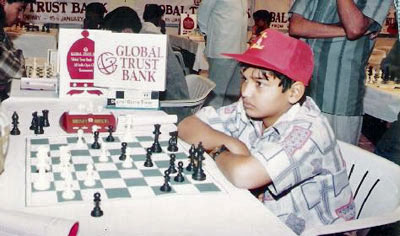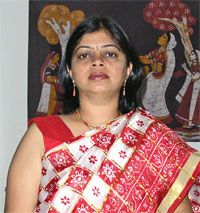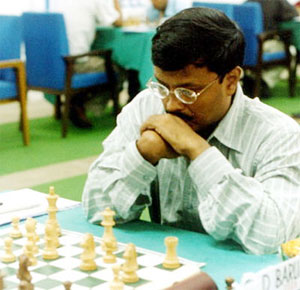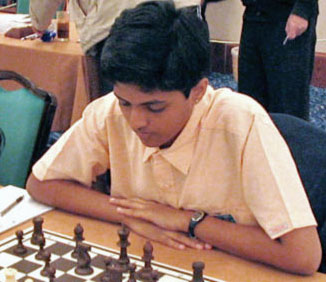 We
asked you to guess who this smart young boy was, and provided some more or less
helpful clues:
We
asked you to guess who this smart young boy was, and provided some more or less
helpful clues:
-
today this player is over 25 years old – actually he is
37, and will turn 38 on December 11th.
-
he is a strong grandmaster, over 2600 on the Elo scale –
he is currently rated 2792
-
his current rating is not his highest ever, but his ranking is –
his highest rating ever was 2803, in April 2006, when he became the fourth
player in history to break the 2800 barrier. Today at 2792 he is the highest
ranked player in the world.
-
originally he wanted to become a tennis player, but because of the
early morning practice hours he switched to chess – see the first
story below.
-
he is predominantly a 1.e4 player – though he has been known
to play 1.d4 on rare occasions.
-
he is passionately interested in astronomy and cosmology. Recently
we heard him discuss the role of acceleration in Einstein's twin paradox
with a quantum physicist – this was at a lunch in Dortmund, where
he quizzed a young German physicist named Vera Spillner, who is doing a
PhD on string theory, and a second one on the philosophical interpretation
of time. Megachick.
-
he has a fine sense of humour – and a knack putting things
in their right perspective. At the above lunch he asked: "So you guys
understand the start of the universe down to the first 10-40
(ten to the power of minus 40) seconds? Everthing that came after that is
a piece of cake. It's just the first 10-40 that you need to work
on?" Yes, said Vera, that about wraps it up.
-
he speaks three languages fluently, but his first language is English
– Anand speaks Tamil, English and Spanish (and is currently picking
up German fast). Although he speaks Tamil with his parents and his wife
Aruna, he can express himself best in English.
-
we are basically fairly sneaky people, here in the ChessBase newsroom
– the above clues, while all true, were meant to lead people astray.
But they didn't. Over 70% of the visitors who wrote in guessed it correcly:
it is of course Vishy Anand, the Indian chess superstar. Most recognised him
by looking at the eyes. The picture was taken from the following article in
the Indian magazine Sify, carried on the 60th anniversary of Indian independence.
We quote it with kind permission of the author.

The story of Indian chess
By Manisha Mohite
 |
The Amritrajs were going great guns in tennis in Chennai (then Madras) in the
1970s, and inspired by this, an eight-year-old was enrolled for tennis
classes.
Two days with an early 5.30 am schedule and two rounds to run around
a large playground, and the youngster decided that tennis was not his
calling! Whether tennis lost out on a great player is debatable but what
is undeniable is that chess certainly was a gainer, for this child was
Viswanathan Anand, currently ranked World number one, and one who then
went on to dominate World chess and single handedly ushered in a chess
revolution in India and Asia. In fact, the progress of chess in India
can just be categorised as ‘before Anand’ and ‘since
Anand.’
Left: Viswanathan Anand dressed up and all set to go for chess classes
as a six year old.
|
 |
Even though the origins of the game can be traced almost 3000 years back
to India, the first player to hit the international scene was the legendary
Mir Sultan Khan in the1920s when he accompanied his employer to England.
This player from Punjab won the British Chess Championships in 1929, 1932
and 1933, and also represented England in three Olympiads, defeating many
leading players, the major casualty being former World Champion Jose Raoul
Capablanca. Ranked amongst the top ten in the World then, Sultan Khan’s
chess exploits ended tragically after his return to India with his employer
in 1933 and he faded into obscurity.
Thereafter, there was a lull and only post Independence did we have Manuel
Aaron winning the National title a record nine times and becoming India’s
first International Master (IM) in 1961. The scintillating Khadilkar sisters,
Vasanthi, Jayshree and Rohini dominated women’s chess for a decade
from the inaugural version in 1974, with all three becoming Women International
Masters. They abruptly quit the chess scene, leaving plenty of potential
unfulfilled and their disappearance unanswered.
Left: India’s first world-class chess player, Mir Sultan Khan. |
 |
It was then that lightning struck Indian chess in the form of Viswanathan
Anand. Rapid-fire moves, tactical strokes and chess understanding way beyond
his age had people flocking to his table at the Tal Chess Club, where the
six-year-old started his tryst with destiny. In 1983, the 13-year-old, fighting
heavy fever and wrapped in a blanket, demolishing the unshakable Aaron,
using just half an hour on his clock, was a sight to behold. This was a
signal that we were to witness the most glorious chapter in the history
of Indian sports.
Anand’s fast play earned him the tag of ‘Lightning Kid’
as he overcame his opponents in whirlwind fashion. The metamorphosis to
'Speed King’ was equally swift and lethal and even today there is
none to match his speed and skill in the Rapid versions of the game. Utut
Adianto, Asia’s first super GM, sums, “Anand is very gifted.
When analysing positions, he would have already seen 15 or 20 moves ahead
even before most of us had registered the position in our mind.”
1987 was historic, with Anand becoming the first Asian to be crowned
World Junior Champion and then the country’s first grandmaster.
Sensational victories against the then invincibles, Anatoly Karpov and
Garry Kasparov in the same tournament at Tilburg in 1991, were followed
by Anand winning the Reggio Emilia in 1992, the strongest ever chess tournament.
The so called Grand Slam events like Corus, Linares, Dortmund and Rapid
events like Chess Classic of Frankfurt nee Mainz were conquered time and
again by Anand.
Left: A teenaged Anand on his way to becoming the ‘Speed King.’
|
 Anand with other chess greats: seated: Mikhail Tal, Joel Lautier,
Anand; standing: Bent Larsen, Viktor Korchnoi, Garry Kasparov, Bessel
Kok, Jan Timman, Boris Spassky
Anand with other chess greats: seated: Mikhail Tal, Joel Lautier,
Anand; standing: Bent Larsen, Viktor Korchnoi, Garry Kasparov, Bessel
Kok, Jan Timman, Boris Spassky
|
| Anand stumbled twice in his attempts to become World Champion, first at
the Professional Chess Association finals against Kasparov in 1995 and then
against Karpov at Lausanne in 1998 in the FIDE knock-out World Championship.
“Karpov was seeded directly and unfairly in the final, just waiting
for me and I was delivered to him like a corpse directly after playing some
grueling matches,” said Anand later to this writer but former World
championship challenger Viktor Korchnoi commented “Anand is very talented
and brilliant but lacks the toughness to be a world champion.” The
year 2000 was another landmark as Anand destroyed and demolished all opposition
to finally win the World title, at Delhi and Iran. What was endearing
was that he was hailed a ‘Gentleman Champion’ in reference
to his non-controversial, ever-smiling character, admired and adored by
players and organisers alike. Anand has won the award for highest supremacy
in chess, the Chess Oscars, thrice. Incidentally, Bobby Fischer was the
only non-Russian to win this award before. Anand is only the fourth player
in the World to cross the magical but elusive 2800 rating mark after Kasparov,
Vladimir Kramnik and Veselin Topalov.
|
Even as Anand set up a scorching trail, there was another compatriot,
Dibyendu Barua from Kolkata, equally talented or gifted but sadly eclipsed.
He caught international attention by defeating Korchnoi as a 16-year-old
and till date is the only Indian to win a board Gold medal, at the Chess
Olympiad in 1990.
His brilliant play in adverse positions earned him the tag ‘Indian
Houdini’, but his lack of opening preparation denied him his dues.
Barua’s is one talent that promised a lot more but faded away, mostly
due to lack of facilities and finances. |
|
 Little Pentala Harikrishna is all seriousness even as a kid
Little Pentala Harikrishna is all seriousness even as a kid
|
| Chess in the nineties and the millennium became altogether a new story
in India. The children and their parents were equally enthusiastic in following
the footsteps of India's most successful son. Suddenly, children's chess
started exploding in India and we had Pentala Harikrishna winning the World
under-10 title in 1996. Then followed Koneru Humpy with a clutch of age-level
World titles, and soon India started dominating in Age Category events at
Asian as well as world level. Harikrishna broke Anand’s Indian records
as the youngest IM and GM, and also won the World junior. Humpy went a step
ahead and set a world record as the youngest ever to win the World Junior
Girls title at 16 years. Humpy, trained by her father, is ranked second
in the World after Judit Polgar of Hungary. The 20-year-old is undoubtedly
pointed out as a potential Women’s World Champion.
Krishnan Sasikiran is another success story inspired by Anand. Though
Sasikiran did not make a mark in Age Categories, his steady and determined
play had him breaking into the elite 2700 ELO mark. Humpy won the first
Individual Gold medal for chess at the Doha Asian games in 2006 and then
combined with Sasikiran and Harikrishna to bag the team Gold. In fact,
this trio have to their credit many Asian championships and Commonwealth
championships.
|
| According to the latest ratings, Anand, Sasikiran and Harikrishna are
rated in the top 50, while in the women’s section we have Humpy, Harika
and India’s first WGM Vijayalakshmi Subbaraman ranked amongst the
top 20. In fact, Vijayalakshmi has won two silver medals at Chess Olympics
and a bronze medal. Anand is quick to point out that Indian chess is going
through one of its healthiest phases. He says, “There are lots of
young players coming up the talent pool with a lot more Federation, Government
and Private sector backing. All these are indicators that chess is growing
and the talent search is happening on a broader platform. Humpy, Sasi and
Hari are clearly our strongest contenders. They are at a critical stage
in their career, where they could make the next break through.”
After this trio, there is a lot more promising potential in the form
of Parimarjan Negi who broke Harikrishna’s record of becoming the
youngest Indian GM. Dronavalli Harika has also won a clutch of Gold medals
at Age Categories and there are many more talented youngsters who are
promising to bloom. Comparisons with Anand are inevitable for any rising
star in India but former World Championship Nigel Short however cautions”
Don’t make the mistake of comparing the young players with Anand,
for he is a genius and the others are still unfinished products”. |
|
 Manisha
Mohite
Manisha
Mohite
The author of the above overview of chess in India is the newspaper journalist
Manisha Mohite, who lives and works out of Pune, India. She is a welcome colleague
at chess tournaments, to which she travels all over the world. Sometimes the
journey can take her over
60 hours.
Manisha writes for a variety of newspapers and magazines, including Sify Sports,
where the above article originally
appeared.



















 We
asked you to guess who this smart young boy was, and provided some more or less
helpful clues:
We
asked you to guess who this smart young boy was, and provided some more or less
helpful clues: 





 Manisha
Mohite
Manisha
Mohite 




